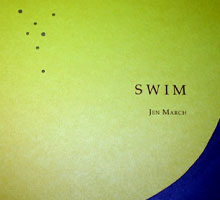Swimming Out
Maggie Ryan Sandford reflects on SWIM, a new poetry-film project by writer Jen March and filmmaker Peter Hogan, who've recently formed a collaborative production outfit for more such creations, called Co-Kisser.


There’s a new art form on the horizon: poetry-film. Approaches to the burgeoning genre are many, but the work is unified by intention: to shed light on and expand the boundaries of poetry in ways words alone can not. Poetry-film projects have been popping up all over in recent months: Todd Boss and Angella Kassube’s Motionpoems, a short film re-visitation of The Waste Land by writer Jay Orff and animator Tom Schroeder (both of Monkeyshow). There was even a panel discussion and series of screenings about the trend last spring at the Chicago Public Library, “Glass Darkly: Combining Poetry and Film in the Internet Age”. Recently, Twin Cities audiences were also treated to SWIM, a new collaboration by poet Jen March and fledgling filmmaker Peter Hogan.
Based on March’s recently released poetry collection of the same name, SWIM is a 31-minute “poem-film” which attempts to illuminate March’s collection as a whole. Unlike some poetry-film artists, March and Hogan decided not to include full readings from the collection in the piece, instead allowing the film and the chapbook to accompany one another, like a pairing of food and wine. It includes some poetic narration, but also ambient sound, hyper-realistic dialogue, and an original score by local artists. The visuals consist of two kinds of shots: the protagonist/narrator (played by March herself) moving contemplatively through her daily life, and images of items on which she may be meditating: a bird, a baby and its mother, a traffic crossing, water.
One of the first lessons of reading poetry is to assume that the poet has been intentional in every choice she makes. Applying the same criteria to SWIM, it’s easy to accept that the artists intentionally used a low resolution camera to give their footage a gritty, disjointed feel. Many of the shots March and Hogan chose to include are brilliant in their simplicity: abstract shots of the cables on the Midtown Greenway bridge, the narrator’s eyes in her rearview mirror, watching a train go by, the narrator and her lover engaging in a sort of in-and-out-of-frame kitchen dance — washing grapes, opening a beer. As with the subtle, intentional imagery in March’s writing, these moments feel at once casual and sacred. Like any good poetry, such choices allow the viewer to simply feel the cadence of the piece, and develop their own interpretation of its meaning.
But another lesson of poetry — especially of writing poetry — is to edit like crazy. Some of the film’s shots begged for a slightly higher resolution, or at least more light. And though March managed, for the most part, to seem natural on camera, there were perhaps a few too many shots of her walking forlornly, presumably meditating on her unspoken dissatisfaction with her mother, her lover, and herself. In these moments, I found myself wishing I had the book in front of me instead, unable to shake the feeling that I could glean more from March’s carefully chosen lines than from her representations of sadness on-screen. True, the film’s storyline helps the viewer understand more about the poet herself, or at least something about the images which she intends to conjure in her poems. But if one believes the words of Robert Frost, “Poetry is what is lost in translation,” does poetry-film translate too well? Or, as the artists seem to intend, is it worthwhile to have one piece of art multiply itself into two?
March is a gifted poet, and Hogan has proven to have a good eye for film, and the combination of their talents is, in its best moments, truly moving. And perhaps the best thing about SWIM is the excitement of what’s to come. The duo’s recent screening coincided with their launch of “Co-kisser,” a web-based, collective, poetry-film project that invites poets and filmmakers to make poetry-films of their own. Introducing the evening, Hogan said that when he met March, her energy made him want to be “an artist who does things.” Thanks to their collective efforts, Co-kisser not only mobilizes artists to do, but encourages them to strike out into largely uncharted territory. And that’s invigorating — modern art to a T.